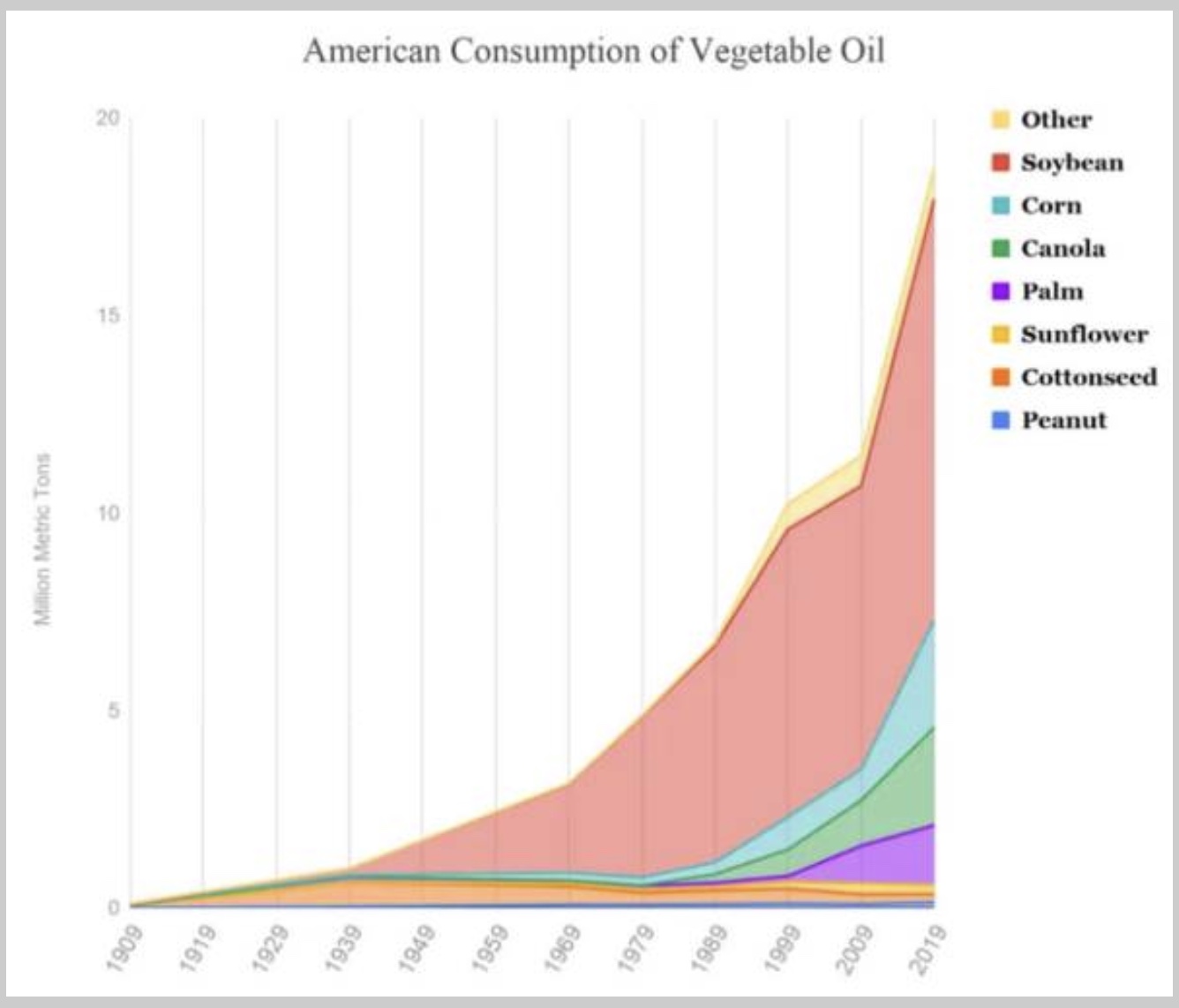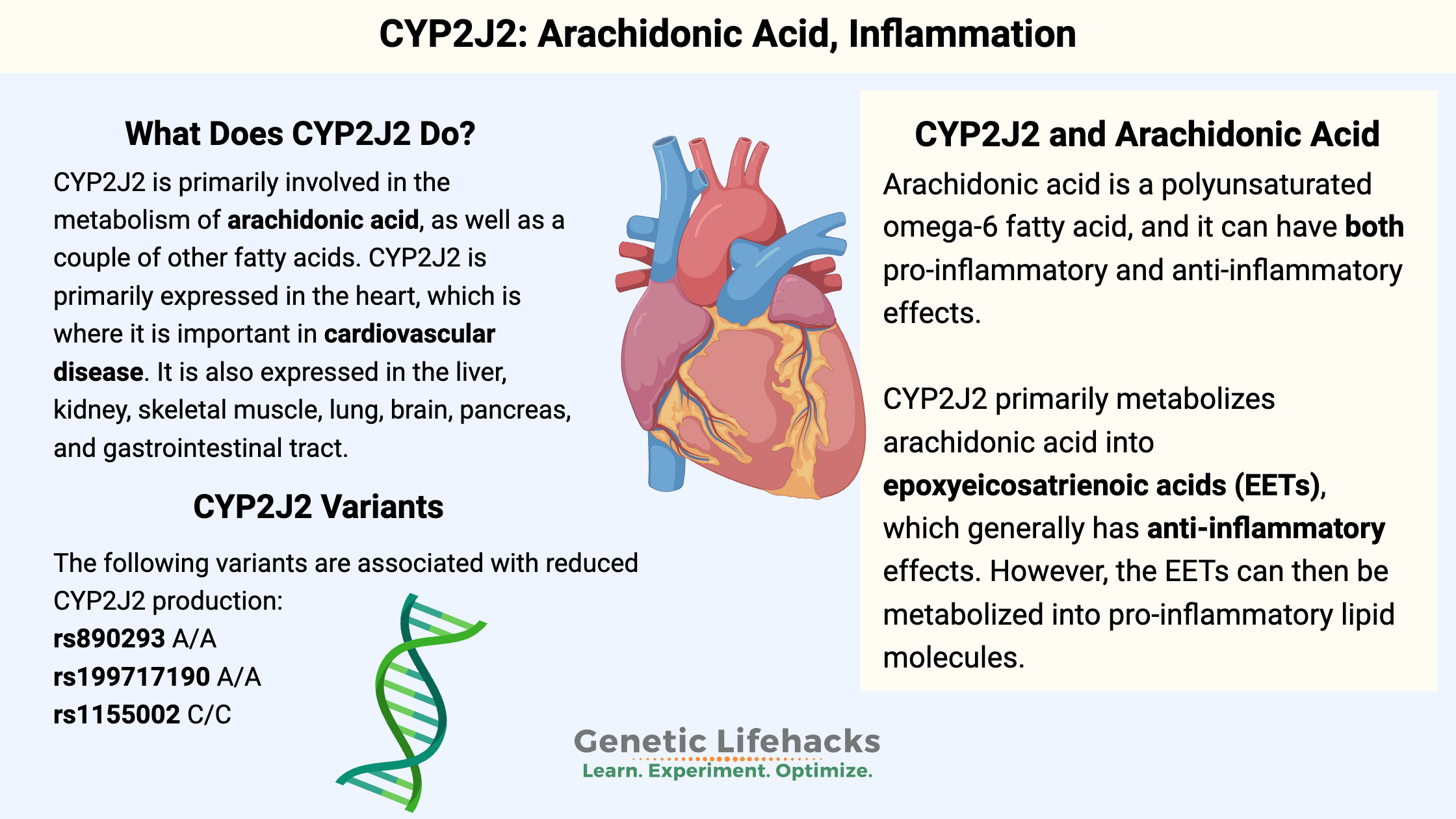Key takeaways:
~ CYP2J2 is a gene in the CYP450 family of phase I detoxification enzymes.
~ Arachidonic acid and other polyunsaturated fatty acids are turned into bioactive signals by CYP2J2.
~ Genetic variants in CYP2J2 can increase the risk of heart disease.
Members will see their genotype report below and the solutions in the Lifehacks section. Consider joining today.
What does CYP2J2 do in the body?
The CYP450 family of enzymes breaks down (metabolizes) endogenous compounds that the body produces naturally, as well as toxins or drugs.
While the focus of research on most CYP genes is on drug interactions, for CYP2J2, research shows that it plays an important role in heart health, kidney health, and in response to omega-6 polyunsaturated fatty acids (PUFA).
Interestingly, a new study has found that CYP2J2 and polyunsaturated fatty acid intake may play a causative role in autism spectrum disorder (ASD).[ref] This may be one way our modern dietary shift toward higher omega-6 seed oils interacts with the increase in ASD.
CYP2J2 and arachidonic acid metabolism:
CYP2J2 is primarily involved in the metabolism of arachidonic acid, as well as a couple of other fatty acids.
Arachidonic acid is a polyunsaturated omega-6 fatty acid. It can be converted from linoleic acid, which is abundant in oils such as safflower, corn, soybean, cottonseed, grapeseed, and walnut oils. AA is also found in foods such as chicken, turkey, beef, and eggs.
Fatty acids can be used in cells as signaling molecules to promote or defend against inflammation. Arachidonic acid is a precursor for several bioactive lipid mediators, including prostaglandins, thromboxanes, leukotrienes, and epoxyeicosatrienoic acids (EETs). These lipid mediators are involved in many physiological processes, including inflammation, immunity, and vascular function. Thus, arachidonic acid can have both pro-inflammatory and anti-inflammatory effects in the body, depending on how it is metabolized and used.
In the “inflammatory” pathway, arachidonic acid is the precursor for prostaglandins and thromboxanes, which promote inflammation, pain, and fever. Arachidonic acid is also the precursor for leukotrienes and HETEs, which are also inflammatory.
However, through the CYP pathway, arachidonic acid can be metabolized to produce epoxyeicosatrienoic acids (EETs), which generally have anti-inflammatory effects.
Let’s dig into the anti-inflammatory EETs, and then go into the pro-inflammatory downside here.
CYP2J2 and the EETs: Anti-inflammatory effects
CYP2J2 is primarily expressed in the heart, which is where it is important in cardiovascular disease. It is also expressed in the liver, kidney, skeletal muscle, lung, brain, pancreas, and gastrointestinal tract. [ref]
One role of CYP2J2 is to convert arachidonic acid to EETs — specifically 5,6-EET, 8,9-EET, 11,12-EET, and 14,15-EET.[ref] The CYP2J2 enzyme can also convert DHA and EPA (omega-3 fatty acids) to EEQs, which act similarly to EETs in being anti-inflammatory in the heart and blood vessels.[ref]
EETs are anti-inflammatory and can inhibit NF-kB and reduce inflammation in the endothelium (lining of blood vessels). EETs can also cause blood vessels to relax, lowering blood pressure and generally benefiting cardiovascular health.[ref] Genetic variants that decrease the function of CYP2J2 cause a decreased conversion of arachidonic acid to EETs and are associated with an increased risk of cardiovascular disease.[ref]
From anti-inflammatory to pro-inflammatory:
However, there’s a tradeoff with EETs — they can be converted quickly into pro-inflammatory diols by an enzyme called soluble epoxide hydrolase.[ref]
Arachidonic acid, ASD:
I mentioned at the beginning of this article that there’s a new study out looking at arachidonic acid, the CYP2J2 and CYP2C enzymes, EETs, diols – and their connection to autism.
Dietary Shift:
The ratio of omega-6 to omega-3 fatty acids in the modern diet is significantly different from what our ancestors ate even a few generations ago. The increased consumption of oils such as corn, safflower, and soybean oils has shifted the modern diet to be many times higher in omega-6 fatty acids than at any time in history.[ref] From 1959 to 2008, the average amount of omega-6 linoleic acid incorporated into adipose tissue more than doubled.[ref]
One difference in children with autism that has been repeatedly shown in studies is that their arachidonic acid and total omega-6 levels are higher compared to DHA and EPA (omega-3) levels than in children without autism.[ref]
A recent study looked at the levels of fatty acid metabolites in the umbilical cord blood of infants who later developed ASD. The study was conducted in Japan using information from thousands of cord blood samples collected between 2007 and 2011. The researchers then used samples from 200 births in which 70% of the children scored above a certain level on autism spectrum tests (and the other 30% served as controls). The results of the study showed high levels of arachidonic acid-derived diols (total diHETrE, 11,12-diHETrE), with elevated levels affecting symptom severity and social affect. Interestingly, animal research shows that glyphosate interacts with EET levels in the brain during development by increasing soluble epoxide hydrolase and proinflammatory diols.[ref][ref]
How does this connect to CYP2J2? There are no studies specific to CYP2J2 polymorphisms and autism that I can find. However, higher CYP2J2 levels may increase EETs, which may combine with soluble epoxide hydrolase in some children to increase pro-inflammatory diols.
Medications metabolized by CYP2J2:
CYP2J2 is also involved in the breakdown of a few medications. However, most of these are also metabolized by CYP3A4, so you may not have problems with the medications unless you also have CYP3A4 variants.[ref][ref][ref]
- astemizole
- ebastine
- nabumetone
- albendazole
- cyclosporine A
- terfenadine
- mesoridazine
- thioridazine
Medications that inhibit CYP2J2:
Danazol and telmisartan are potent inhibitors of CYP2J2[ref][ref]
Next up, let’s take a look at how specific SNPs can impact how your CYP2J2 gene functions:
CYP2J2 Genotype report
Lifehacks:
Dietary considerations:
While the conversion of arachidonic acid (omega-6) to EETs has some positive aspects for heart disease, it can be a double-edged sword in the presence of soluble epoxide hydrolase, which then increases pro-inflammatory molecules.
Research shows that CYP2J2 also converts DHA and EPA (omega-3s) into anti-inflammatory molecules that are of benefit to the heart and blood vessels. Importantly, there is a higher binding affinity for CYP2J2 with DHA. [ref]
Reducing omega-6 fats and increasing DHA in the diet may help reduce the increased risk of heart disease in people with CYP2J2 variants. Historically, the intake of linoleic acid (omega-6, precursor of arachidonic acid) was about 2g/day in 1865 and increased to 5g/day in 1909. In 2008, the average intake of linoleic acid was 29g/day, which is a huge increase as a percentage of total caloric intake.[ref]
The biggest sources of omega-6 fats in the modern diet are fried foods (French fries, chicken, potato chips, fried pastries) and sauces (mayo, salad dressings). Cookies and bread from the store are also likely to contain omega-6 oils.[ref]
Avoiding fried foods, junk foods, and mayo-based sauces will reduce your omega-6 intake to a more historically natural level.
Seed oils high in omega 6 include soybean, safflower, corn, cottonseed, sunflower, canola, and peanut oils.

Increasing DHA/EPA:
The flip side of the equation here is that most of us don’t get as much DHA and EPA as prior generations consumed.
Good sources of DHA and EPA omega-3 fatty acids include:[ref]
- Salmon roe (caviar)
- Halibut
- Herring
- Salmon
- Sardines
- Trout
Medication interactions:
Most of the medications that are metabolized by CYP2J2 are also metabolized by CYP3A4. Check to see if you have genetic variants in CYP3A4:
| Gene | RS ID | Effect Allele | Your Genotype | Notes About Effect Allele |
|---|---|---|---|---|
| CYP3A4 | rs4987161 | G | -- | CYP3A4*17 decreased function |
| CYP3A4 | rs4986909 | A | -- | CYP3A4*13 decreased function |
| CYP3A4 | rs2740574 | C | -- | CYP3A4*1B altered function |
| CYP3A4 | rs4986910 | G | -- | CYP3A4*3 decreased function |
| CYP3A4 | rs4986907 | T | -- | CYP3A4*15A decreased function |
| CYP3A5 | rs776746 | C | -- | CYP3A5*3 non-functional –most common type in Caucasians |
| CYP3A5 | rs28365083 | T | -- | CYP3A5*2 non-functional |
| CYP3A5 | rs55817950 | A | -- | CYP3A5*8 non-functional |
| CYP3A5 | rs28383479 | T | -- | CYP3A5*9 non-functional |
| CYP3A5 | rs41279854 | T | -- | CYP3A5*10 non-functional |
| CYP3A5 | rs56244447 | T | -- | CYP3A5*3D non-functional |
| CYP3A4 | rs28371759 | G | -- | CYP3A4*18, increased function; lower active vitamin D and lower BMD |
| CYP3A4 | rs2242480 | T | -- | TT: CYP3A4*36, decreased function; increased serum 1,25(OH)2D3 |
Talk with your doctor or pharmacist if you have questions on specific medications and how they may work for you.
Related Articles:

